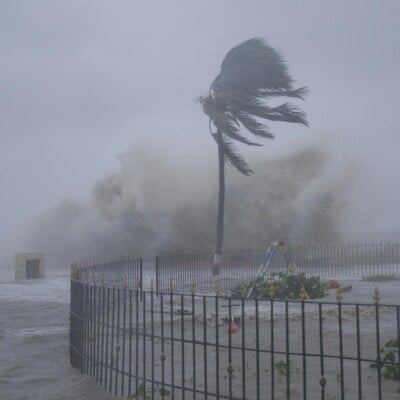Hurricane Beryl pounded Jamaica on Wednesday with strong winds and heavy rain, leaving at least one person dead as it made a destructive path that flooded the small Caribbean island in recent days.
The death toll from the powerful Category 4 hurricane has risen to at least 10, but is expected to rise as communications are restored on islands battered by flooding and fierce winds.
Click here to connect with us on WhatsApp
In Jamaica, emergency workers rushed to evacuate people from areas at risk of flooding after Beryl’s eyewall skirted the island’s southern coast, battering communities.
“It’s terrible. Everything is gone. I’m scared to be in my house,” said Amoy Wellington, 51, a cashier from Top Hill, a rural town in the parish of St. Elizabeth in southern Jamaica. “It’s a disaster.”
A woman was killed in Hanover Parish, Jamaica, when a tree fell on her home, Richard Thompson, acting director of Jamaica’s Disaster Management Authority, told local news in an interview.
Thompson added that by Wednesday evening, about 1,000 Jamaicans had been evacuated to evacuation centres.
The island’s main airport was closed and streets were largely empty after Prime Minister Andrew Holness imposed a nationwide curfew on Wednesday.
“We will do everything humanly possible and leave the rest to God,” Governor Holness said early Wednesday, urging residents in risk areas to evacuate.
The loss of life and damage caused by Beryl highlights the impacts of a warming Atlantic Ocean, which scientists say is a clear sign of human-induced climate change that is contributing to more extreme weather than previously experienced.
Ralph Gonsalves, prime minister of St. Vincent and the Grenadines, one of the hardest-hit areas in the eastern Caribbean, said in a radio interview that his country’s Union Island had been “devastated” by Beryl.
“Everyone has lost their homes. It’s going to be a huge effort to rebuild.”
Nerissa Gittens MacMillan, permanent secretary at St. Vincent and the Grenadines’ Ministry of Agriculture, told state media that food shortages were possible after 50 percent of the country’s plantain and banana crops had been lost and root crops and vegetables had also been badly damaged.
There were widespread power outages across Jamaica and parts of roads near the coast were washed away.
By Wednesday evening, the swirling eye of the hurricane was located about 100 miles (161 kilometers) west of Kingston, and the center of the storm was heading toward the Cayman Islands, where it is expected to achieve hurricane conditions later tonight, according to the National Hurricane Center (NHC).
Beryl has maximum sustained wind speeds of 130 miles per hour (209 km/h).
The NHC warned that winds were expected to weaken somewhat over the next day or two, but that Beryl would remain at or near major hurricane strength as it passed over the Cayman Islands.
Beryl is expected to dump 4 to 6 inches (10 to 15 centimeters) of rain on the Cayman Islands overnight and into Thursday, and the NHC said large swells were expected to “produce life-threatening rough seas and low tides.”
The center added that hurricane warnings had been issued for Jamaica, the Cayman Islands, the east coast of Mexico’s Yucatan Peninsula and the country’s top beach resort city of Cancun.
“Like Armageddon”
Additional deaths confirmed so far include at least three in St. Vincent and the Grenadines, where more than 90 percent of buildings were destroyed on Union Island, a government official told Reuters.
In Grenada, Prime Minister Dickon Mitchell said the situation was “Armageddon-like” with power outages and widespread destruction, and confirmed three deaths.
In Venezuela, President Nicolas Maduro told state television that three people were killed and four were missing in the region, and that heavy rains had damaged more than 8,000 homes, including at least 400 that were destroyed.
Venezuelan Vice President Delcy Rodriguez was injured on Tuesday when she was hit by a falling tree while inspecting an area in southern Berrill where heavy rains had caused the Manzanares River in Sucre state to overflow, the president confirmed.
The unusually early hurricanes have strengthened in record time, and scientists say climate change is almost certainly to blame.
Beryl is the first hurricane of the 2024 Atlantic season and the earliest storm on record to reach the highest category on the Saffir-Simpson scale. The National Oceanic and Atmospheric Administration (NOAA) predicts a large number of major hurricanes during this year’s “exceptional” season.
The NHC warned that in addition to short-term impacts on Jamaica and Haiti, Beryl was likely to make landfall as a hurricane on Mexico’s Yucatan Peninsula as early as Thursday night.
In the fishing village of Punta Allen in Quintana Roo state, residents moved their boats inland for safety while naval officers urged reluctant residents to evacuate.
In the tourist capital of Cancun, environmental groups are collecting eggs from sea turtle nests in an effort to protect the species.
Tourists made the most of the sunshine while they still could.
Meanwhile, workers have been filling stores with sandbags and boarding up doors and windows for protection, and officials said supplies of wooden planks are dwindling as Cancun residents and tourists prepare for the beryl’s arrival.
Mexico’s civil defense chief, Laura Velazquez, told local broadcaster Milenio that tourists in Cancun and nearby Tulum should seek shelter in hotel basements as the hurricane approached.
(Only the headline and photo of this report may have been modified by Business Standard staff. The rest of the content is auto-generated from a syndicated feed.)



